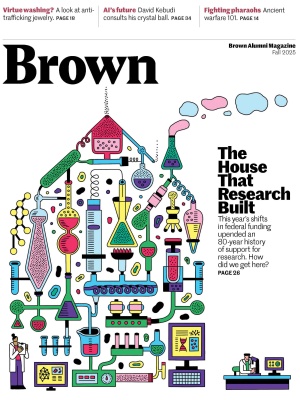What Brown Stands For
A new Statement of Values and Voice provides a roadmap for the future
The Corporation of Brown University approved a formal Statement of University Values and Voice during its annual May meeting, outlining four core values to guide Brown in fulfilling its mission for generations to come: the pursuit of knowledge and understanding; academic freedom and freedom of expression; a commitment to openness and diversity of ideas, perspectives, and experiences; and responsibility for a thriving academic community.
While Brown’s charter and mission statement have guided the institution for generations, the University had never before defined its core institutional values, President Christina H. Paxson wrote in a May 28 message to the Brown community. Nor had Brown clearly set forth when the University should, or should not, use its “voice” as a public statement or action that intentionally expresses a position on an issue.

Under the new guidelines, “use of University voice should concern only those issues that directly influence the University mission.” The statement adds that Brown “must refrain from expressing positions on topics unrelated to its mission because doing so risks undermining the public trust, damaging the conditions necessary for academic freedom, and preventing fulfillment of the University mission.”
Developed by a faculty-led committee over several months, the statement reflects the thoughtful input of thousands of members of the Brown community, Paxson noted. “From the outset, it was important that it […] have durability as a lasting framework for University decisions and actions now and into the future.”
When the committee shared a first draft in March, nearly 800 students, faculty, staff, and alumni submitted written feedback, and thousands more attended town halls and campus meetings.
The discussions “grappled with deeper issues about what it means to be a university, why universities exist, and what society needs from them,” Professor of Ecology, Evolution, and Organismal Biology James R. Kellner, who chaired the committee, told the BAM. “Alumni have a lot to say about all that. And they have a voice that transcends the current political moment.”
Kellner says the committee heard from alums from the classes of the 1950s right up to the current day. “That’s particularly important when you’re talking about an institution as old as Brown. There really won’t ever be just one understanding of what it is,” he observes. He adds that he was struck by how deeply alumni cared about Brown, even as they expressed differing visions of their alma mater. “It’s not that the view of someone who was here in the ’50s is more correct than that of someone who was here in the ’70s or ’90s. But when you hear from alumni over many decades, you get to see the perspectives of people at different times in U.S. history, and you can distill them down to some common elements.”
Before the statement was submitted to the Brown Corporation, it passed a faculty vote by 72 percent.
In an explanatory report, the committee notes that it sees a distinction between the Brown statement and the way “institutional neutrality” has come to be commonly defined nationally. “The committee recognizes that the University will sometimes be compelled to ‘take collective action’ through the use of its voice to establish a position on an issue to advance or defend its mission,” the report states. “The fact that an issue is politically partisan, socially contested, or morally ambiguous does not mean that the University cannot address it through the use of its voice. The question is whether the use of University voice is aligned with the mission and core institutional values of the institution or not.”
For more, see From the President, page 1; and brown.edu/about/mission.





